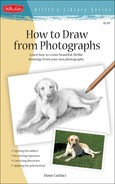Just because we’re creating a realistic drawing from a photo reference doesn’t mean we want our drawing to be identical to the source. After all, part of being an artist is imbuing each of your pieces with your personal style! One of the best ways to develop your style and become comfortable with adding your own personal touches is to get in the habit of daily sketching. Start making quick studies, taking fifteen minutes or so out of your day to develop your skills and your eye.

Tree on a Hill When I sketch like this, I like to use a large lead so I don’t focus on details. After establishing the shapes with a 2B, I switch to the side of a 6B large lead for tone, pressing harder for shadows and using short up-and-down stroke on the hill.

Cypress Trees Limit the time you spend on each subject so that you’re forced to focus on the main masses and not the details. Establish the basic shapes and angles, and then quickly indicate texture and tone.

Field with Trees I also find the stump helpful for quick toning. Here, I use a stump with some graphite on it to smear tone over the tree shapes in a circular motion. I also lightly touch tone on the hill before going over the trees with the side of a large-lead 6B.



